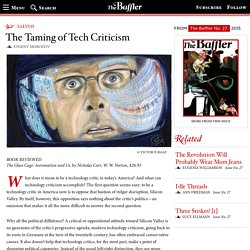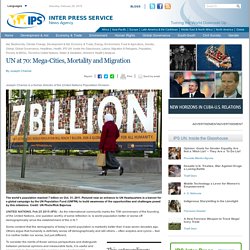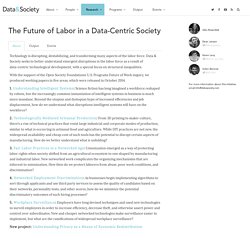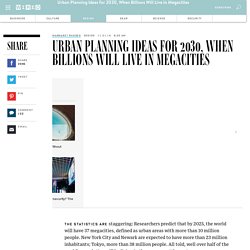

The Taming of Tech Criticism. BOOK REVIEWEDThe Glass Cage: Automation and Us, by Nicholas Carr, W.

W. Norton, $26.95 What does it mean to be a technology critic in today’s America? And what can technology criticism accomplish? The first question seems easy: to be a technology critic in America now is to oppose that bastion of vulgar disruption, Silicon Valley. Why all the political diffidence? Most contemporary American critics of technology—from Jaron Lanier to Andrew Keen to Sherry Turkle—fall into the cultural-romantic or conservative camps.
Meanwhile, a more radical strand of tech criticism, confined mostly to university professors, barely registers on the public radar. That radical critique of technology in America has come to a halt is in no way surprising: it could only be as strong as the emancipatory political vision to which it is attached. Postcards from the Futch — The Message. In the future what will the future mean for the future of the future?

In the future will futures create new futures for futures? What future might the future bring? We have reached a point where titling something “The Future of” looks antiquated, a blast from the internet culture near past. And, by the way, this isn’t a new idea. Dystopia Tracker. UN at 70: Mega-Cities, Mortality and Migration. Aid, Biodiversity, Climate Change, Development & Aid, Economy & Trade, Energy, Environment, Food & Agriculture, Gender, Global, Global Governance, Headlines, Health, IPS UN: Inside the Glasshouse, Labour, Migration & Refugees, Population, Poverty & MDGs, TerraViva United Nations, Water & Sanitation, Women's Health | Analysis Joseph Chamie is a former director of the United Nations Population Division.

The world's population reached 7 billion on Oct. 31, 2011. Pictured near an entrance to UN Headquarters is a banner for a global campaign by the UN Population Fund (UNFPA) to build awareness of the opportunities and challenges posed by this milestone. The Future of Labor in a Data-Centric Society. Technology is disrupting, destabilizing, and transforming many aspects of the labor force.

Data & Society seeks to better understand emergent disruptions in the labor force as a result of data-centric technological development, with a special focus on structural inequalities. With the support of the Open Society Foundations’ U.S. Programs Future of Work inquiry, we produced working papers in five areas, which were released in October 2014. 1. Understanding Intelligent Systems: Science fiction has long imagined a workforce reshaped by robots, but the increasingly common instantiation of intelligent systems in business is much more mundane. 2. 3. 4. 5. New project: Understanding Privacy as a Means of Economic Redistribution. One fatal crash a week by 2030 inevitable, says aviation expert. Dubai to 'become centre of the world' A senior statistician has predicted that Dubai will become the centre of the world, snatching the title from London, by the year 2100.

Speaking during the UAE Government Summit 2015 in Dubai, Dr. Hans Rosling, Co-Founder of Gapminder, said that population growth in Africa and Asia would push the centre of focus from Europe to Dubai. Past visions of future cities: where are our flying cars and hoverboards? The city of the future has been invented again and again.

In science fiction stories, in altruistic urban plans, in the unbuildable designs of architectural provocateurs, the city has a long and robust history of taking on new forms within the human imagination. Be they prophecy, speculation or simple entertainment, such visions have infiltrated the general consciousness, setting grand expectations and perhaps causing some disappointment at the substandard world we’re stuck with. Where are our flying cars? Where Did the Future Go? David Graeber vs. Peter Thiel. Don’t Worry About the Future. By Anna Aslanyan.

Beta-Life, edited by Martyn Amos and Ra Page (Comma Press, 2014) “Futures involving teleportation, adjustable gravity, truly immersive games, driverless cars. They never arrived!” These reassuring words are from “Bruno Wins!” , a short story by Frank Cottrell-Boyce included in Beta-Life. RSA East Midlands sur Twitter : "NESTA predictions 2015 - awesome! @nesta_uk: Listen to the podcast: @pesska #2015predictions... After the Future – Franco “Bifo” Berardi.
Franco Berardi’s After the Future explains the changing terrain of the future.

The future has become precarious. Twentieth century politics had a grasp on the future; it would be the realization of speed, progress and human strength. This notion of the future is rooted in modern capitalism, the indefinite expansion of capitalism into every corner of the world and of life. Berardi posits that all modern political ideologies share a “true faith” in the future and progress.
Bill Gates and the future. Urban Planning Ideas for 2030, When Billions Will Live in Megacities. The statistics are staggering: Researchers predict that by 2025, the world will have 37 megacities, defined as urban areas with more than 10 million people.

New York City and Newark are expected to have more than 23 million inhabitants; Tokyo, more than 38 million people. All told, well over half of the world’s population will be living in these super settlements. “One number that isn’t referenced often is that two-thirds of that population will be poor,” says Pedro Gadanho, who curated Uneven Growth: Tactical Urbanisms for Growing Megacities at MoMA. That poverty translates into informal cities, like the favelas of Rio de Janeiro or illegally subdivided high-rises of Hong Kong. What Gadanho, and MoMA, want to explore is: How can urban planners work with these urban residents, not against them, to make cities more livable for everyone? Click to Open Overlay Gallery. Future of News: Timeline of the connected generation.
28 January 2015Last updated at 02:54 ET Predicting the future is a challenge at the best of times.

During the current period of rapid technological change, it is particularly tricky. Undaunted, the innovation team at BBC News Labs have tried their hand here at charting a timeline of key future developments for technology and news, as well as some recent milestones. 2003: Friendster, the first social network, launches Its initial success will be followed by even more popular social networks taking over, namely Facebook in 2004, and Twitter in 2006.
Predictions About The Last Decade, From Futurists In 2005. Since 1968, the Institute for the Future, located in tech-centric Palo Alto, California, for most of its existence, has made a business of helping organizations prepare for the future. Every year, the institute offers up a 10-year forecast—its look at how the world could change over the next decade. We tend to cover IFTF's work with an eye towards the future, but it's also worthwhile to look at whether they've been correct in the past. Urban Solutions for the World in 2030. Istanbul: Tactics for Resilient Post-Urban Development (2014): KITO compound (courtesy Atelier d’Architecture Autogérée) Around the world people are rapidly moving to cities in an incredible manifestation of consolidated growth. The Museum of Modern Art’s Uneven Growth: Tactical Urbanisms for Expanding Megacities is the culmination of a 14-month initiative to address developing problems — from affordable housing to the limits of available land — in six of those cities, by involving the communities most impacted.
According to the UN’s World Urbanization Prospects report, by 2030 the global population is expected to surpass eight billion. How Would You Describe Your Sustainable City in 2030? What Will Work Look Like In 2030? The idea of work in the past 15 years has changed so much that it’s difficult to imagine what the next 15 years will look like. According to a new study published by commercial real estate services CBRE and Genesis, a real estate developer from China, many of the ideas, trends, and behaviors that will shape work in 2030 is already evident today. However, some of these changes are quietly emerging and business leaders might not truly understand the significance of their impact on performance, productivity, and retaining talent.
Marintec China. Global Marine Trends 2030 “Prophecy is a good line of business, but it is full of risks.” So said author Mark Twain. Top Ten Priorities for Getting to 2030. A New Year’s Reality Check, 15 Years In… Where does the time go? Just last week we celebrated the arrival of 2015, in all of its New Year’s freshness and possibility.
And while I’m happy to greet the new year with streamers and champagne, I have to admit I’m feeling a bit more serious than that. 15 is a significant number, a milestone worthy of note. We’re 15 years into the 21st century. 15 years into the modern green building movement. 15 years to 2030 and halfway through our timeline for the 2030 Challenge. The Future of Drugs. Amazon.com: Brave New Now (Lisbon Architecture Triennale - Close, Closer ebook series 1) eBook: Warren Ellis, Tim Maughan, Jonathan Dotse, Bruce Sterling, Rachel Armstrong, Samit Basu, Anil Menon, Hoving Alahaidoyan, Liam Young: Kindle Store. Robotics and Autonomous Systems.
Providing smooth and reliable transport for London’s burgeoning population is already a challenge, but what will happen when another 10 million people enter the equation? This is the challenge faced by John Downes, Head of Engineering Governance & Services at London Underground. Transport for London (TfL), which oversees the Underground, is on the hunt for innovative proposals to help solve the capital transport conundrums.
“The challenge is moving towards London,” Downes told delegates at last month’s RAS in Horizon 2020 event. “London will have 10 million additional inhabitants by 2030, it’s as if the current population of Birmingham moved to the capital.” To deal with this population surge, the city has to have a very efficient network in palace and we must lever off the technology, he stressed. To encourage companies to work with TfL, the organisation has established a Technology Innovation Portal allowing users to speedily input ideas and solutions that meet key challenges. Customer. Aquapods Are the Future of Oceanic Fish Farming.
face perilous declines We’ve surpassed our capacity to sustainably fish wild caught fish, shrimp, and mollusks from the ocean, and so we’ve turned to aquaculture, or fish farming, as a strategy to meet demand for our growing appetites for water-borne critters. 10 Ways the Next 10 Years Are Going To Be Mind-Blowing. 5 Brazilian Problems Tech Can Help Fix. The Coming Era of Mega Systems, Part 1 – Transportation. NASA Study Proposes Airships, Cloud Cities for Venus Exploration. Cops of the future? British bobbies get a sci-fi makeover. Home Office researchers are looking into a range of sci-fi equipment that will transform British police officers into figures closer to Robocop than Dixon of Dock Green. Innovations on the Home Office wishlist includes a robotic exoskeleton to take the load off weary legs, a range of wearable computers including Google Glass-type spectacles and body armour made from graphene (the novel material that earned its discoverers a Nobel prize in 2010).
The monitored office: Dystopian future workplace or efficient business of tomorrow? Biometrics and wearables are making their way into the workplace as employers modernise access control and time-keeping. But with no legal framework in place, does this trend benefit businesses or violate employees’ rights? The pressures facing businesses today are enormous. The economic crisis, competition in the marketplace and the continued rise of the data-driven culture mean employees are expected to work smarter and faster than ever before.
Against this backdrop, it is little wonder that technology that promises to help people do just that is generating excitement in boardrooms across the world. From Coca Cola to Apple and hundreds of companies in between, biometric and wearable technology is being explored to make businesses run quicker, safer and in a more cost effective way. Early adopters suggest these types of technology are having a positive impact on performance but critics warn that a surveillance culture can lead to stress, sickness absence and higher staff turnover. The future of energy? Earth in the Future [Documentary] The Future of Shopping. Photography: Rachel Perry Welty and Yancey Richardson Gallery, NY. P2P Foundation. Trends at Work: An Overview of Tomorrow’s Employment Ecosystem. Inside The Near-Future World Where All Our Data And Machines Are In Constant Communication.
How the Victorians invented futurism – Iwan Morus. Egyptology can help us future-proof our culture – Grayson Clary. Arup Foresight. How Disruptive Innovation Is Leading Us To A Post-Capitalist World. 12 Futuristic Forms of Government That Could One Day Rule the World. Le monde dans 100 ans vu par 10 économistes: des robots partout, de l'agriculture en Sibérie. 10 Horrifying Technologies That Should Never Be Allowed To Exist. Global Strategic Trends out to 2045. DCDC GST 5 Secured. Future - Five perplexing questions about computers in 2039. The Future of Transportation. The 4 Transportation Systems You'll Meet in the Future.
Transhumanism Has a Conspiracy Theory Problem. FUTURESTATES - Browser Not Supported. How climate change will impact South Asia – latest IPCC report. 10 Diseases That Might Afflict Us In The Future.